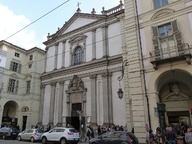Ritratto di Sigismondo Pandolfo Malatesta
Ce portrait de Sigismondo Malatesta, seigneur de Rimini (1417 - 1468), reprend l'image officielle du prince, fixée par les médailles de Pisanello (1445). Le tableau est à mettre en rapport avec la fresque exécutée en 1451 par Piero au Tempio Malatestiano de Rimini, représentant le condottiere, de profil, agenouillé devant son saint patron Sigismond, roi des Burgondes. On a supposé, sans preuve, qu'il pourrait s'agir d'une première pensée en vue de cette composition.
Sigismond Malatesta (1417-1468), seigneur de Rimini, nommé en 1430 vicaire général de l'Eglise, fut l'un des condottières les plus brillants de son temps. Orgueilleux de ses succès, il attira sur lui la jalousie du pape Pie II qui l’excommunia en 1460. Dès lors, ses luttes contre la papauté valurent à ce protecteur des arts une réputation de cruauté et de paganisme. Sigismond grandit dans une famille cultivée, liée aux milieux humanistes, notamment à la cour des Este à Ferrare : sa première épouse, Ginevra (1419-1440) était la fille de Niccolo III, marquis de 1393 à 1441. Il transforma Rimini en un foyer important de la Renaissance, faisant appel aux plus grands artistes. Alberti (1404-1472) conçut pour lui la façade de San Francesco, église de Rimini où les Malatesta avaient leur sépulture. Sa décoration intérieure, aux allures païennes, valut à cet édifice le nom de Tempio Malatestiano. C’est là que Piero della Francesca exécuta, en 1451, une fresque représentant Sigismond, de profil, agenouillé au pied de son saint patron. Les liens existant entre cette fresque et le portrait du Louvre invitent certains à penser que Piero aurait pu peindre ce dernier avant 1451 et l’utiliser comme modèle pour la peinture murale.
Cette représentation d’un personnage richement vêtu, en buste et de profil, suit la tradition du portrait de cour, prisé par les foyers de l’Italie du Nord qui reste attaché au style du «gothique international». Elle s’inspire de l’art de la médaille auquel les humanistes fascinés par l’Antiquité classique donnèrent un nouvel essor. Mais à la différence des visages faiblement modelés par Pisanello, celui de Malatesta surgit du fond sombre et se détache en relief. Piero, présent à Florence en 1439, a sans doute été impressionné par les expériences que les peintres y menaient alors sur la représentation de l’espace et du volume. Ainsi, à la différence du Portrait d'une jeune princesse de Pisanello (Louvre), l’épaule du personnage, strictement de profil, est décrite selon les normes d’une vision en perspective, bien que figurée en raccourci. Grâce aux jeux de lumière, son cou est puissamment modelé à la manière d’une colonne. L’artiste tend à une géométrisation des formes, sensible notamment dans la ligne des cheveux, qui suit exactement la diagonale du tableau.
De plus, Piero enrichit ici sa connaissance de la peinture florentine d’une méditation sur l’art flamand dont il existait à la cour de Ferrare (où il séjournait vers 1448-1450) plusieurs témoignages, en particulier un triptyque de Rogier Van der Weyden (1399/1400-1464). L’analyse de la matière picturale a montré que par endroits Piero avait mêlé de l’huile à l’œuf, liant traditionnel de la peinture italienne de l’époque. Seule l’utilisation de l’huile, plus souple que l’œuf, pouvait lui permettre d’atteindre cette perfection dans le rendu des carnations : le modelé subtil, les effets de transparence (la chair sous l’ombre bleutée de la joue rasée) et cette précision dans les touches lumineuses (le fil de lumière sous le menton). C’est grâce à cette technique, inspirée des exemples flamands, que Piero crée l’illusion de vie qui se dégage du portrait.
COMMENTI
LE OPERE
 Il Battesimo di Cristo
1450 | Tempera su tavola | 116 x 167 cm.
Il Battesimo di Cristo
1450 | Tempera su tavola | 116 x 167 cm.
 Il sonno di Costantino
Affresco
Il sonno di Costantino
Affresco
 Pala di Brera o Pala Montefeltro
Tempera su tavola
Pala di Brera o Pala Montefeltro
Tempera su tavola
 San Nicola da Tolentino
1454 | Tecnica mista
San Nicola da Tolentino
1454 | Tecnica mista
 Ritratto dei Duchi di Urbino
1465 | Olio su tavola | 47 x 33 cm.
Ritratto dei Duchi di Urbino
1465 | Olio su tavola | 47 x 33 cm.
 Flagellazione di Cristo
1460 | Tempera su tavola | 58 x 81 cm.
Flagellazione di Cristo
1460 | Tempera su tavola | 58 x 81 cm.
 Madonna del Parto
1455 | Affreschi | 260 x 203 cm.
Madonna del Parto
1455 | Affreschi | 260 x 203 cm.
 La Vergine con il Bambino e i Santi
1469 | Tecnica mista | 170 x 248 cm.
La Vergine con il Bambino e i Santi
1469 | Tecnica mista | 170 x 248 cm.
 Polittico della Madonna della Misericordia
1445 | Olio su tavola | 330 x 273 cm.
Polittico della Madonna della Misericordia
1445 | Olio su tavola | 330 x 273 cm.
 Ritratto di Sigismondo Pandolfo Malatesta
1451 | Tecnica mista | 34 x 44 cm.
Ritratto di Sigismondo Pandolfo Malatesta
1451 | Tecnica mista | 34 x 44 cm.
 La Crocifissione
1454 | Tempera su tavola | 41 x 37 cm.
La Crocifissione
1454 | Tempera su tavola | 41 x 37 cm.


